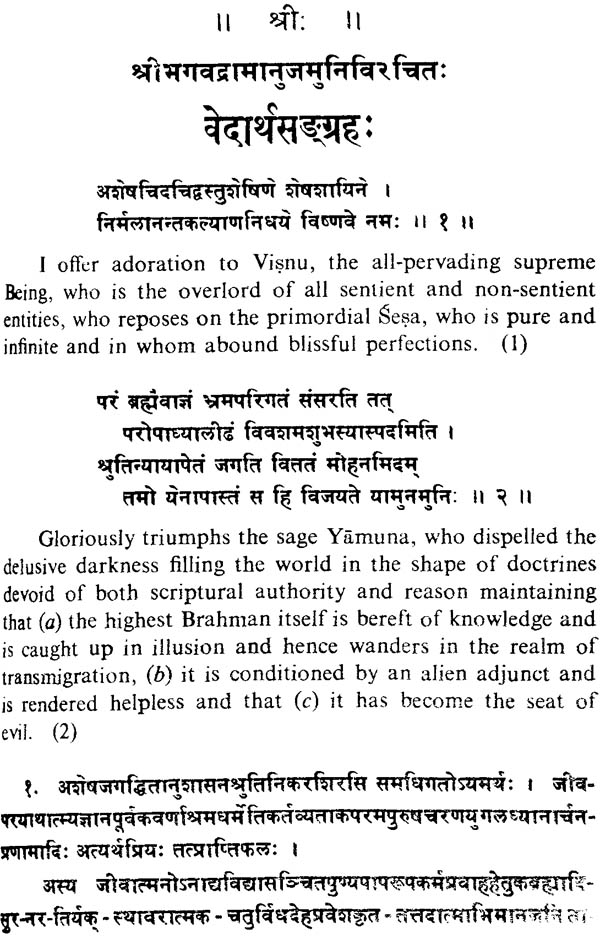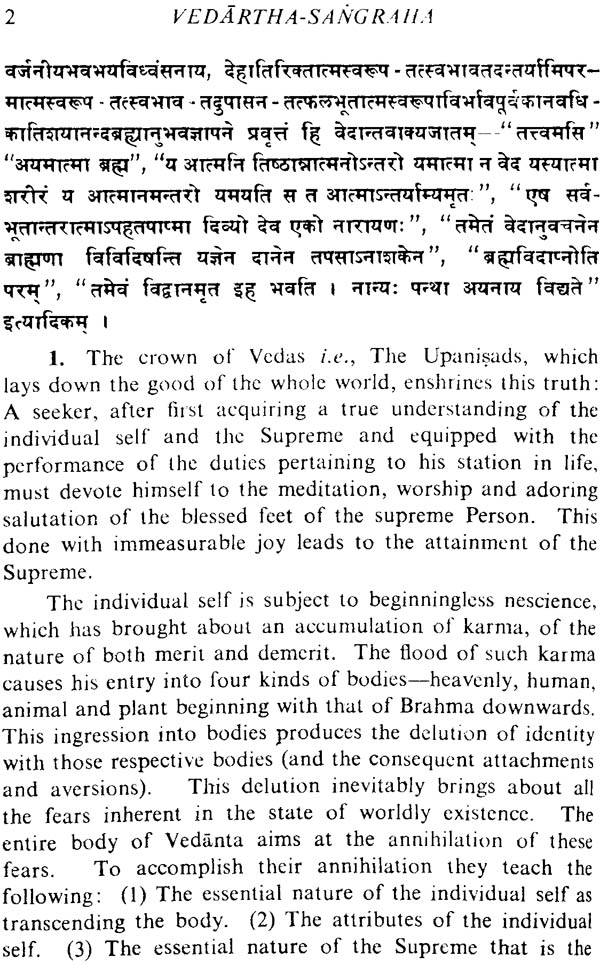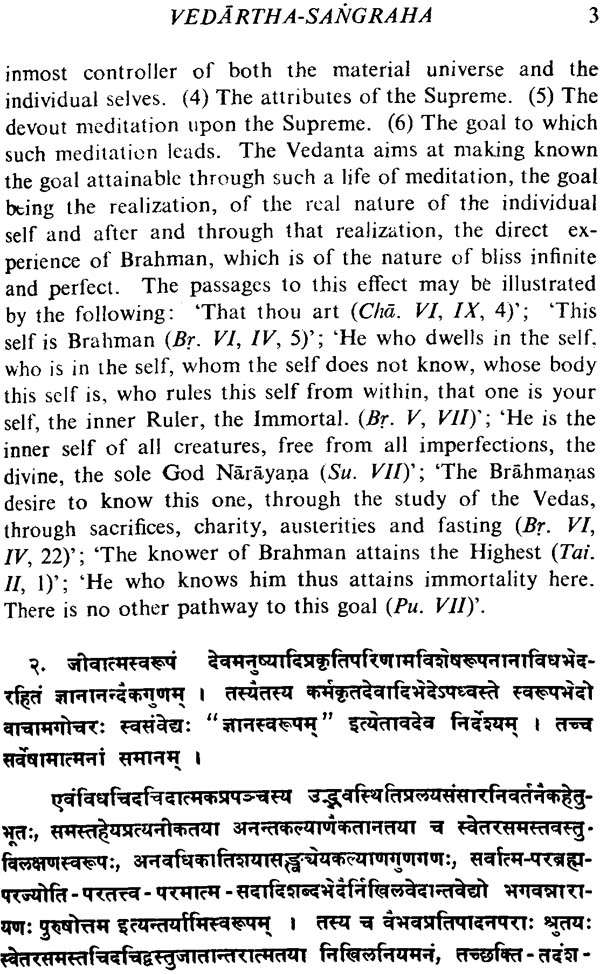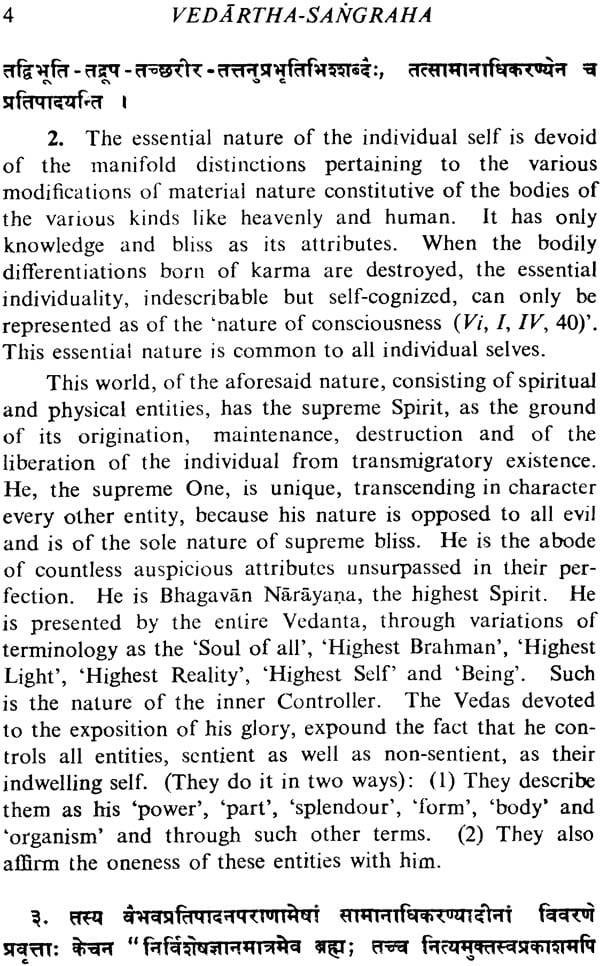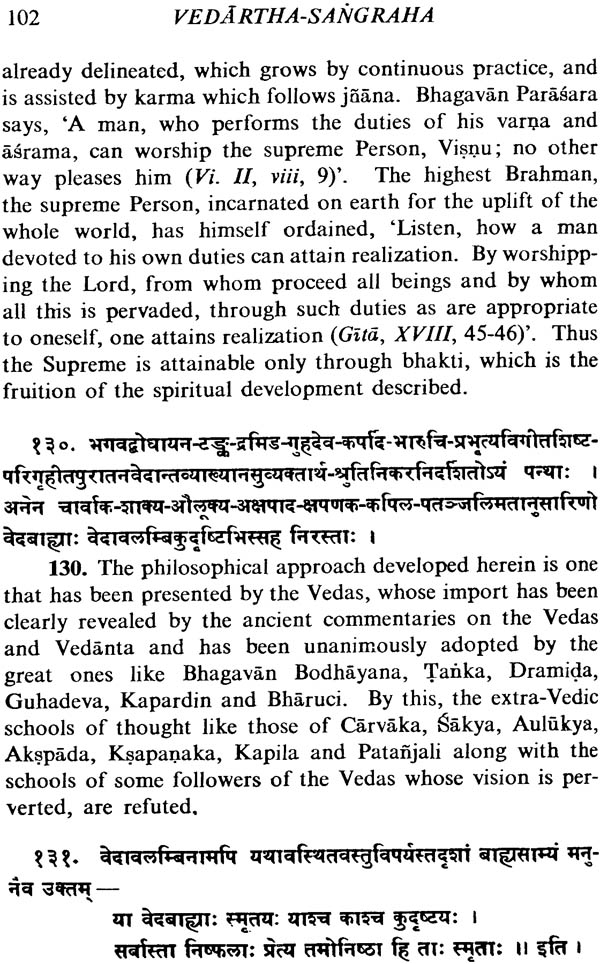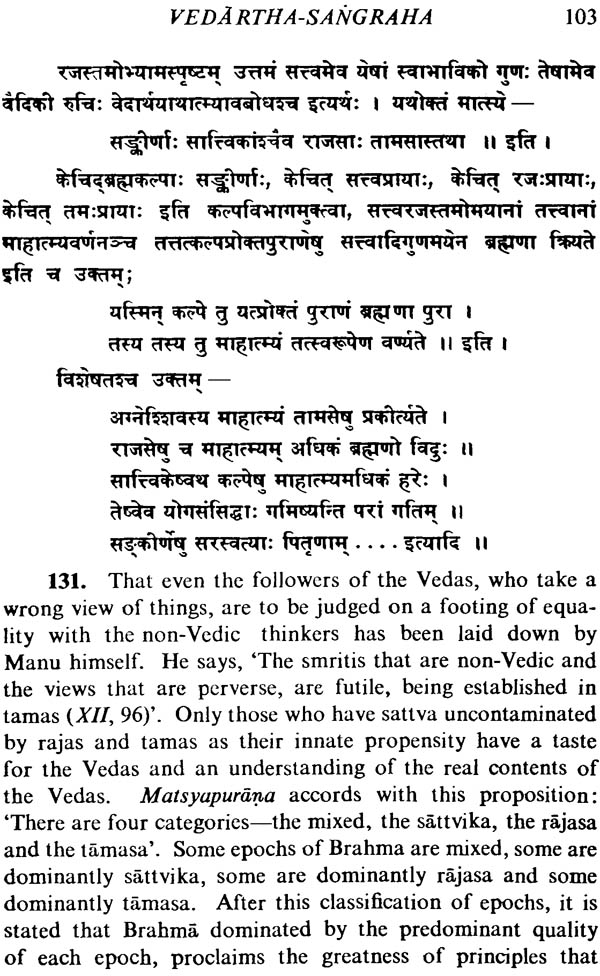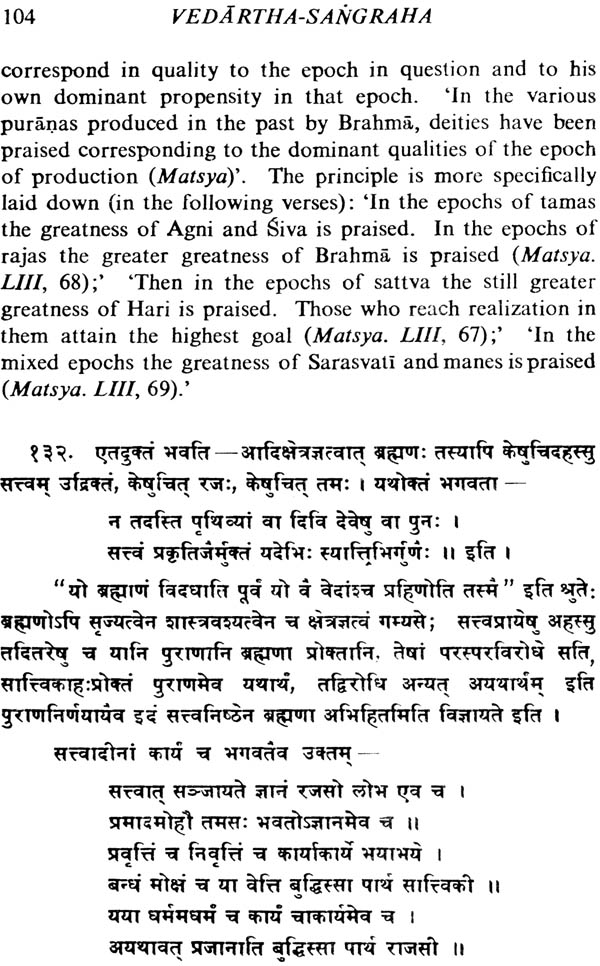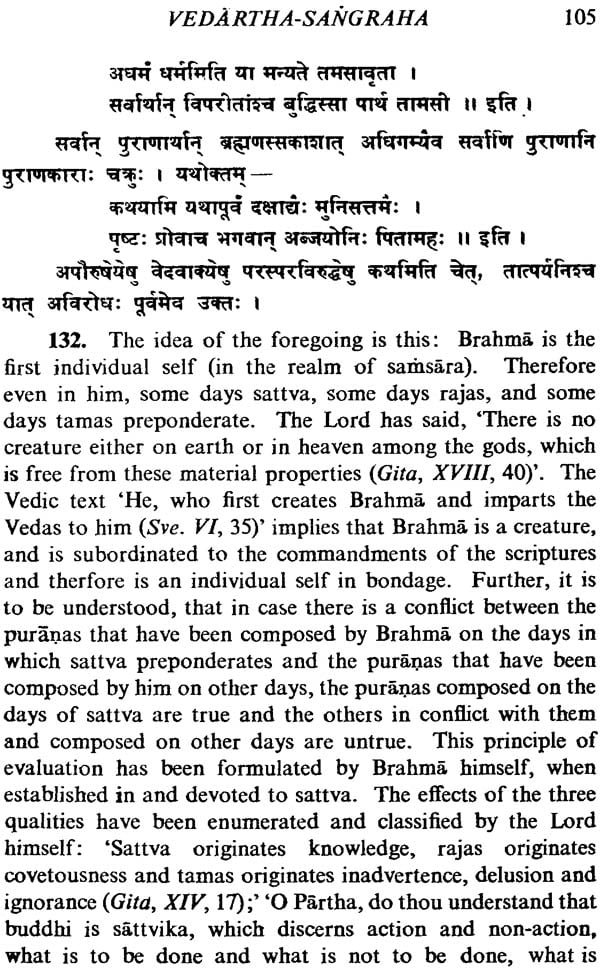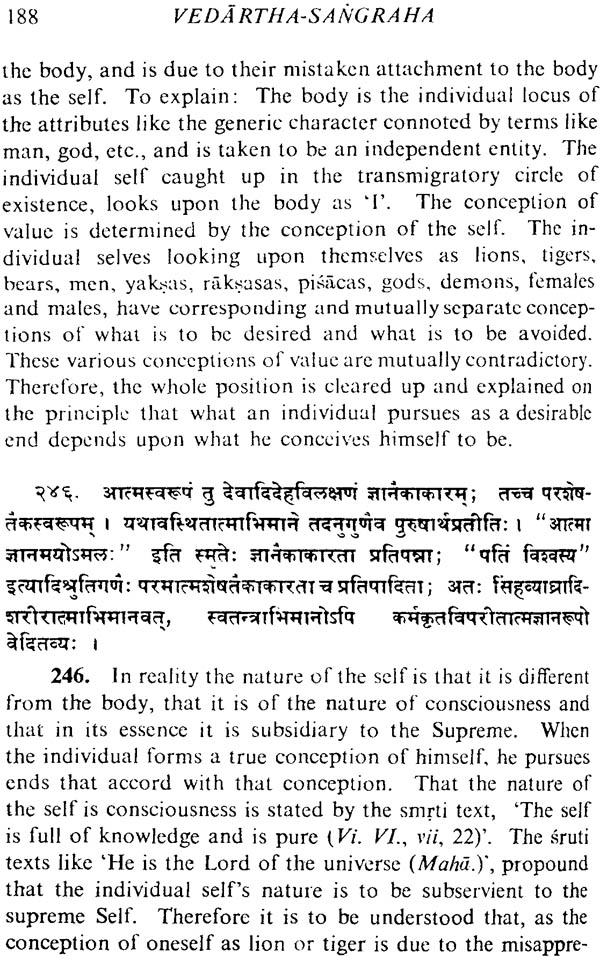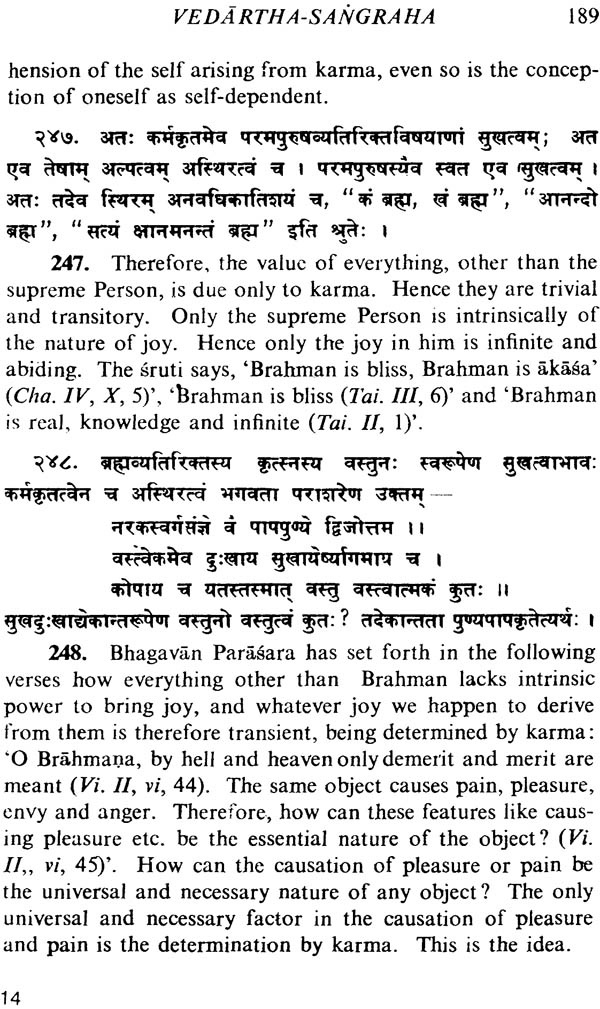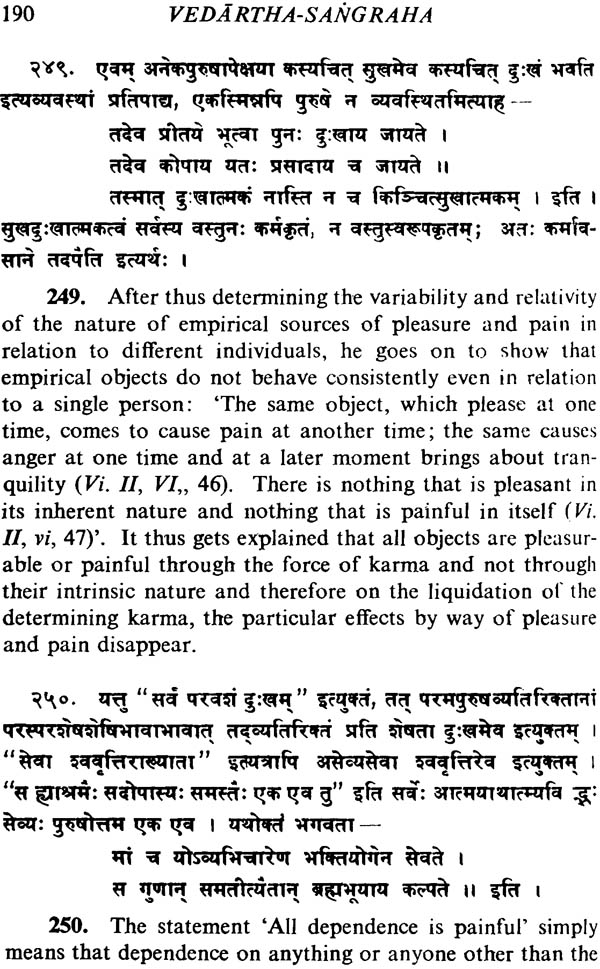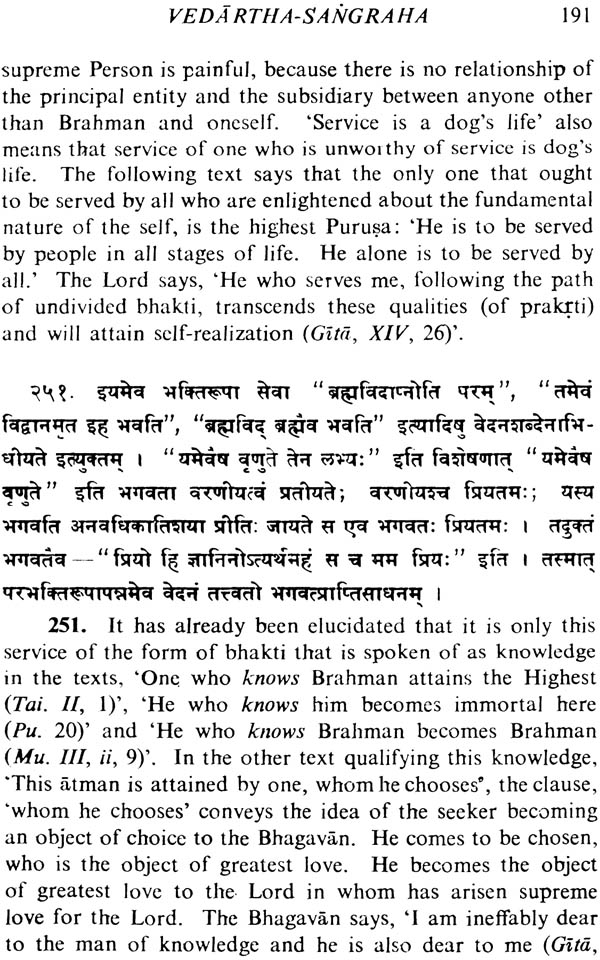
Vedartha Sangraha Of Sri Ramanujacarya
Book Specification
| Item Code: | IDH310 |
| Author: | S. S. Raghavachar |
| Publisher: | ADVAITA ASHRAM KOLKATA |
| Language: | English |
| Edition: | 2012 |
| ISBN: | 8175051183 |
| Pages: | 192 |
| Cover: | Hardcover |
| Other Details | 7.2" X 4.8" |
| Weight | 310 gm |
Book Description
About the Book
Sri Ramanuja wrote nine works in Sanskrit on the philosophy of Visistadvaita. Of these, the Vedartha-Sangraha occupies a unique place inasmuch as the work takes the place of a commentary on the Upanisads. The work mirrors a total vision of the Upanisads, discussing all the controversial texts in a relevant, coherent manner. It is in fact an independent exposition of the philosophy of the Upanisads. Prof. M. Hiriyanna describes it as 'an independent treatise explaining in a masterly way his philosophic position, and pointing out the basis for it in the Upanisads'.
Publisher's Note
It is well known that Swami Vivekananda propagated the Advaita Aspect of Vedanta" and its practical application which he called "Practical Advaitism" for elevating the lives of individuals all over the world. He held, nevertheless, that the "highest Advaitism cannot be brought down to practical life. Advaitism made practical works from the plane of Vishishtadvaitism" (C.W., VI-122). He wrote to Alasinga Perumal in a letter dated 6 May 1895: "All of religion is contained in the Vedanta, that is, in the three stages of the Vedanta philosophy, the Dvaita, Vishishtadvaita and Advaita; one comes after the other. These are the three stages of spiritual growth in man. Each one is necessary . Now, in your journal write article after article on these three systems, showing their harmony as one following after the other, ." (C. W., V 81-82).
Keeping these and similar ideas of Swami Vivekananda in view we have undertaken to re-published one of the most important treatises on Vishishtadvaita of Sri Ramanujacharya, entitled Vedartha Sangraha translated into English by Prof. S. S. Raghavachar. First published in 1968 the book was out of print for quite a few years. We are indebted to Shri Ramakrishna Ashrama, Mysore, the first publisher of the book, for granting us permission to reprint it for the benefit of the interested earnest readers.
Foreword
Sri Ramanuja wrote nine works in Sanskrit on the philosophy of Visistadvaita. Of these, the Vedartha-sangraha occupies a unique place inasmuch as this work takes the place of a commentary on the Upanisads, though not in a conventional sense or form. The work mirrors a total vision of the Upanisads, discussing all the controversial texts in a relevant, coherent manner. It is in fact an independent exposition of the philosophy of the Upanishads. Prof. M. Hiriyanna describes it as 'an independent treatise explaining in a masterly way his philosophic position, and pointing out the basis for it in the Upanisads'. Sudarsana-suri, the celebrated commentator on the Sri-bhasya and the Vedartha-sangraha, says that the work was expounded in the form of a lecture before Lord Srinivasa at Tirumalai. Thus it is his testament at the feet of the Lord whom he served throughout his life. Sri Ramanuja refers to this work more than once in his Sri-bhasya.
The Vedartha-sangraha is written in a lucid, vigorous prose without the usual divisions of chapters, but the structure of the thesis is developed in a scientific manner. Sri Ramanuja refers in this work to ancient teachers of theistic tradition, Bodhayana, Tanka, Dramida, Guhadeva, Kapardin and Bharuci, besides his own teacher, Sri Yamunacarya. Tanka and Dramida are quoted profusely to support his interpretation. He takes abundant help from the Brahmasutras, the Ramayana, the Mahabharata, the Visnu-purana. The Manusmrti and other genuine smrtis in the exposition of his philosophy.
At the outset Sri Ramanuja states that the Upanisads, which lay down the welfare of the whole world, move around three fundamental notions: (1) A seeker must acquire a true knowledge of the individual self and the Supreme; (2) he must devote himself to meditation, worship and the adoration of the Supreme; (3) this knowledge with discipline leads him to the realization of the Supreme. To put it briefly, the first affirms the tattva or the nature of the Reality, the second declares the hita or the means, and the third-states the purusartha or the ideal of human endeavour.
A chief difficulty in understanding the meaning of the Upanisads arises in determining the relation of Brahman to the individual self on the one hand, and to the non-sentient world on the other. There are some texts which declare that the world is only an appearance in the ultimate analysis. There are other texts which affirm that the world is not an appearance, but real and distinct.
Bhartrprapanca, who was anterior to Sri Sankara, held that the self and the universe are identical with and different from Brahman, the triad constituting a unity in variety. That is to say, that the reality is at once one as Brahman and many as the self and the world. For example, an ocean consists of water, foam, waves, etc. as the water is real, so also are the foam, waves, etc. as the water is real, so also are the foam, waves etc. The world, which is a part and parcel of Brahman, is necessarily real. The import of all this is that according to this view the Upanisads teach the eternal difference and identity between Brahman on the one hand, and the self and the world on the other.
Sri Sankara rejects the view of Bhatrprapanca, because mutually contradictory attributes cannot be predicated of one and the same thing. According to Sri Sankara the passages which affirm manifoldness and reality of the world do not embody the essential teaching of the Upanisads. It is a concession made to the empirical view that demands a real world having causal connection with time-space. Since variety is but an appearance having no foundation in the ultimate reality, the true essential doctrine of the Upanisads, according to him, is only pure unity. The individual self is nothing but Brahman itself appearing as finite due to limiting adjuncts which are superimposed on it.
Sri Ramanuja also attempts to systematize the philosophy of the Upanisads, taking the cue from the ancient theistic philosophers. He recognizes three lines of thought in the Upanisads concerning the relation between Brahman, the self and the world: (1) Passages which declare difference of nature between the world, the self and Brahman. Here the world is the non-sentient matter (acit) which is the object of experience, the self is the experiencing conscious subject (cit), and Brahman, the absolute ruling principle. These may be named analytical texts. (2) Passages which teach that Brahmanis the inner self of all entities which constitute his body. For instance, 'He who dwells in the earth and within the earth, whom the earth does not know, whose body the earth is, and who rules the earth within, he is thy Self, the ruler within, the immortal' etc. (Br. III, vii, 3-23). These are called ghataka-srutis or mediating texts. (3) Passages which proclaim the unity of Brahman with the world in its causal as well as effected aspect. The famous text, 'That thou art, O Svetaketu' (Cha. VI 2-8) comes under this category. These may be termed as synthetic passages. Sri Ramanuja lays down that the interpretation of the various passages must be such that they are not made to contradict each other, and not a single passage should be so interpreted as to be divested of its primary significance.
The first group of texts distinguishes Brahman from the world and the individual selves. In a way it emphasizes the transcendent character of Brahman. The second group of texts declares Brahman to be the inner self of all entities. Neither the individual self nor the world can exist by itself. They are inseparably connected with Brahman as his body, and thus are controlled by him. These texts teach duality in so far as distinction is made between body and self, and unity in so far as the self, the substantive element, predominates over and controls the body, its attribute. The last group of texts aim at proclaiming the non-dual character of Brahman who alone constitutes the ultimate Reality. The self and the world, though distinct from each other and real, have a different value. They only exist as a mode or attribute of Brahman. They are comprehended in the reality of Brahman. They exist because Brahman exists.
On this principle of interpretation, Sri Ramanuja recognizes that the passages declaring distinction between Brahman, the world and the self, and those affirming Brahman to be the same in the causal as well as effected aspects, do not in any way contradict the mediating passages which declare that the individual selves and the world form the body of Brahman, and they in their causal state do not admit the distinction of names and forms while in the effected state they possess distinct character.
The notion of unity may be illustrated by the example, 'A purple robe'. Here purpleness is quite different from robe. The latter is a substance while the former is an attribute. This integral and essential relation is not found in the case of a man wearing a wrist-watch. If the former relation is inseparable (aprthaksiddhi), the latter is separable and external A word signifying attribute does not stop after denoting the usual meaning, but extends till it reaches the substantive. This is the true significance of an attribute. The individual selves and the world constitute the body of Brahman who is their inner self. Brahman is the integral principle without whom neither the self nor the world can exist. Hence all names finally denote him.
The way in which Sri Ramanuja interprets the famous text, 'That thou art' (Tat tvam asi) is unique. This is done by means of co-ordinate prediction (samanadhikaranya). In a co-ordinate prediction the identity of the substantive should not be established through the rejection of the natural significance of co-ordinate terms. The indentical import of terms taken in their natural signification should be brought out. The Mahabhasya of Patanjali defines co-ordinate predication thus: 'The signification of an identical entity by several terms which are applied to that entity on different grounds is co-ordinate predication.' In such a proposition the attributes not only should be distinct from each other but also different from the substance, though inseparable from it. In the illustration of a 'Purple robe', the basic substance is one and the same, though 'purpleness' and 'robeness' are different from it as well as from each other. That is how the unity of a 'Purple robe' is established. In the co-ordinate predication asserting indentity between 'that' and 'thou', Brahman himself with the self as his mode, having the self as his body, is pointed out.
The term 'thou' which usually stands for the self here stands for Brahman ('that') who is the indweller of the self and of whom the self is the mode as a constituent of his body. The term 'thou' does not mean the physical body or the individual self. Since Brahman has interpenetrated all matter and self, 'thou' signifies Brahman in the ultimate analysis. The term 'that' signifies Brahman himself as the ground of the universe and the soul of all individual selves. Hence in the identity of 'that' and 'thou' there is no rejection of the specific connotation of the co-ordinate terms. The upshot of the dictum is that the individual selves and the world, which are distinct and real attributes, are comprehended in Brahman. Brahman as the inner self of the jiva-Brahman as the ground of the universe are one. The central principle is that whatever exists as an attribute of a substance, that being inseparable from the substance is one with that substance.
Thus Sri Ramanuja upholds all the three streams of thoughts in the Upanisads, namely, unity, plurality and both. He himself clinches the argument: 'We uphold unity because Brahman alone exists with all other entities as his modes. We uphold both unity and plurality, as the one Brahman himself as all the physical and spiritual entities as his modes and thus exists qualified by a plurality. We uphold plurality as the three entities-the individual selves, the world and the supreme Lrod-are mutually distinct in their substantive nature and attributes and there is no mutual transposition of their characteristics.
The summum bonum is the vision of the supreme Person, known as Brahman or Sriman-Narayana. The chief obstacle in the path towards perfection is the accumulation of evil tendencies. These can be destroyed only by the cultivation of good tendencies. This is followed by self-surrender which generates an inclination towards life divine. Then one has to acquire the knowledge of the Reality from the scriptures aided by the holy teachers. Then the practice of virtues like the control of mind and sense, austerity, purity, non-violence, compassion, etc., becomes easy. Nitya and naimittika duties are to be performed, and prohibited actions are to be avoided-the whole conduct being conceived as the worship of God. God, the embodiment of love and compassion, showers his grace on the aspirant, which puts an end to all his obstacles. Finally bhakti rises which is an enjoyment of bliss in itself. Bhakti is put meditation which has assumed the character of the most vivid and direct perception of the Supreme.
Sri Ramanuja, like his predecessor and teacher, Sri Yamunacarya, declares that bhakti succeeds the twofold training of the mind by karma and jnana. Karma-yoga is performance of duties of one's station in life with no thought of reaping any personal benefit in the spirit of Gita's teachings. Karma that is performed in this manner cleanses the heart. Jnana-yoga, which immediately follows the previous discipline, is meditation upon the individual self as distinct from matter like body, mind, etc., with which it is associated. It helps the aspirant to determine the true nature of one's self in relation to the Supreme. He realizes that he is absolutely subservient to God.
The discipline does not stop with the knowledge of one's self alone. It is incomplete without the knowledge of God. Here the word bhakti does not connote the popular sense in which it is understood. Bhakti-yoga is loving meditation upon God. When the meditation attains the form of 'firm remembrance' (dhruvanusmrtih) characterized by intense love, the vision of the Supreme is attained. It must be mentioned here that the final release is attained after the dissolution of the body. One endowed with such bhakti and self-surrender attains the fitness to earn the grace of the Lord. This bhakti itself is upasana or vidya mentioned in the Upanisads. It is same as knowledge spoken of in the srutis: 'One who knows Brahman attains the Supreme' (Tai. II, I), 'He who knows him becomes immortal here' (Pu. 20), and 'He who knows Brahman becomes Brahman' (Mu. III, ii, 9). As the vision of the Supreme is not possible through ordinary means of perception, he can be seen only through bhakti, which is a unique form of knowledge. This is in consonance with the Gita declaration, 'I am attainable only through undivided bhakti' (XI, 54).
It was already mentioned that the ideal to be realized is the vision of the Supreme. It is an experience of absolute peace, perfection, bliss and freedom, untouched by the cosmic limitations of space and time. Sri Ramanuja is accused of having given a 'picturesque description' of the ideal realm. But a little insight into the spirit of his writings reveals that the ideal is not such a fairyland as it is made out to be. The domain, he points out, is of the nature of pure immutable sattva. It is transcendent without the taints of the material gunas of sattva, rajas and tamas. Similarly the individual self also, in the state of moksa, gives up its material body and assumes a transcendent form. The substance of suddha-sattva is common to God, the self and the realm of the ideal known as nitya-vibhuti. The first chapter of the Kausitaki Upanisad gives a figurative account of the pilgrim's progress till he reaches the feet of God.
The individual self is the essence of knowledge. This knowledge in its attributive aspect (dharma-bhuta-jnana) gets more of less contracted in samsara, but it expands infinitely in the state of moksa. It becomes all-knowing and enjoys perfect bliss and love in divine communion. In short it is an ineffable enjoyment. In this natural state it yields its spirit to the will, glory and adoration of God. Sri Ramanuja characterizes this state as 'ananya-prayojana' having no other end except itself. In this ideal place there is no break in the enjoyment of divine communion.
Sri Ramanuja is not unaware of the criticism that there is subservience to and dependence upon God in his conception of moksa. The critics say that subordination in any form cannot conduce to the joy of self. The divine fetters are not less strong to bind. Further Manu says that servitude is a dog's life. Sri Ramanuja effectively meets this criticism in his characteristic way. He enunciates a principle 'that what an individual pursues as a desirable end depends upon what he conceives himself to be'. Different people pursue different and mutually conflicting values. Hence the notion that independence is happiness proceeds from the misconception that one is identical with the body, mind, etc. this attachment to the body is a sort of dependence itself. Instead of dependence on God, it is dependence on matter. The metaphysical fact is that he is not the body, and consequently there must be something else with which his self is related. There cannot be relation of the principal entity and the subsidiary (sesin and sesa) between any finite objects. The only object with which such a relation can exist is God. Hence dependence on anything other than God is painful and subservience to God is joy and freedom. Similarly bondage is indeed a dog's life when one serves those who are unworthy of service. The only entity which is worthy of love, adoration and service is God. Sri Ramanuja clinches the issue by quoting a text, 'He is to be served by all'. The emancipation consists in service of God, and true bondage is independence of God and service of body.
Sri S. S. Raghavachar, who is a deep student of philosophy, especially of Visistadvaita, has achieved a large measure of success in his difficult task of translation. The learned translator has done a signal service to the students of philosophy by translating this masterly treatise of Sri Ramanuja. I am sure that it will prove to be of great help to the students of Indian philosophy.
Preface
It was nearly two years ago and to be more exact, it was on the birthday of Sri Ramanuja in the year 1954 that the idea occurred to me of the desirability of rendering Vedartha-sangraha into English. The work has struck all students as a magnificent treatise on account of the comprehensiveness of its theme, its vigour of execution and the luminous style of its prose. I immediately communicated my thought to Swami to take up the task and promised all possible help. I set myself to the work and submitted my draft to him for scrutiny, and another copy was submitted to Pandit Hemmige Desikachar. After collecting the detailed observations of the Swami and the criticisms and suggestions of Pandit Desikachar I rewrote the whole translation incorporating all the help thus offered. By the time my work was completed, it came to my notice that nearly fifty years ago a translation of the work had appeared serially in the Brahmavadin of Madras. It was too late for me to benefit from the first translation. So the new translation presented here is an independent one.
The translation is based completely on the Tatparyadipika of Sri Sudarsana-suri whose guidance in the matter of understanding Sri Ramanuja is indispensable and is most illuminating.
I acknowledge with sincere gratitude the help I have received from Pandit H. Desikachar, Sri K. V. S. Tatachar, Sri N. S. Anantarangachar, Vidvan Selva Pillai Sarma and Pandit D. Tangavelan. My indebtedness to Swami Adidevananda is indeed beyond words. He has criticized and guided me at every stage of my work. It is in the fitness of things that the work should go forth with his masterly foreword.
The difficulty in translating a work of this kind is that the grandeur of the original produces deep discontent with one's poor rendering of it. Under this circumstance the translator must satisfy himself with the twin aims of accuracy and intelligibility. The power and beauty of the original are beyond reproduction. How far I have achieved my modest aims I leave it to other to judge. Personally the experience of translation has been a reward in itself as it has enabled me considerably to get into grips with the architectonics of a classic in the philosophy of the Upanisads. I have put on record my analysis of the text and connected reflected reflections in the form of a detailed introduction which is being published by The Mangalore Trading Association (Private) Limited.
Swami Shambhavananda with his characteristic generosity and readiness to help, agreed to publish the work. I acknowledge most gratefully my indebtedness to him for giving my humble work the sanctifying recognition of the great Order bearing the name of Sri Ramakrishna. I am grateful to Swami Somanathananda for the kind interest he took in the work and for making the necessary arrangement for its publication.
I acknowledge with sincere gratitude the uniform courtesy and good work of the management of the Sharada Press. My particular thanks are due to Sri A. S. Kamath, who took a personal interest in the work and has expeditiously brought out the book in a fine form.
In preparing the text I have consulted three editions and have depended throughout on the reading adopted by the Tatparya-dipika. The editions consulted are:
1. The edition in Telugu characters published by the Saraswati Bhandara, Madras, in 1883.
2. The Devanagari edition of Pandit Rama Misra Sastri published by Mesrs. E. J. Lazarus & Co., Benares, in 1924.
3. The Devanagari edition in the Sri Vaishnava Sampradaya Granthamala, published by T. T. Devasthanams, Tirupati, in 1953.
| 1 | Priliminary statement of the philosophy of the Upanisads | 1-2 |
| 2 | Substance of Advaita philosophy | 3 |
| 3 | Bhaskara's view | 4 |
| 4 | Yadavaprakasa's view | 5 |
| 5 | Examination of the First view (a) In the light of scriptures (b) In terms of pure reason | 6-44 45-67 |
| 6 | Examination of Bhaskara's view | 68-74 |
| 7 | Examination of Yadavaprakasa's view | 75-80 |
| 8 | Constructive standpoint | |
| (a) Tattvamasi | 81-87 | |
| (b) Brahman as the material cause | 88-93 | |
| (c) Brahman is the import of all terms | 94-98 | |
| (d) The heart of the scriptures | 99-108 | |
| (e) The classification, interpretation and reconciliation of the various types of sacred texts | 109-122 | |
| (f) The question of the freedom of will | 123-125 | |
| (g) Parbhakti, the means for attaining Brahman. | 126-130 | |
| 9 | Narayana is the supreme Brahman | 131-166 |
| 10 | Refutation of the Prabhakara of sruti | 167-197 |
| 11 | The scriptures on the transcendent divine form, Sri, the eternal seers and the transcendent abode of the Lord | 198-226 |
| 12 | The nature of the Vedas | 227-233 |
| 13 | Summary of the metaphysical principles | 234-237 |
| 14 | Summary of the doctrine of Sadhana as bhakti | 238-243 |
| 15 | Service of the Lord | 244-250 |
| 16 | Concluding words on bhakti | 251-252 |
